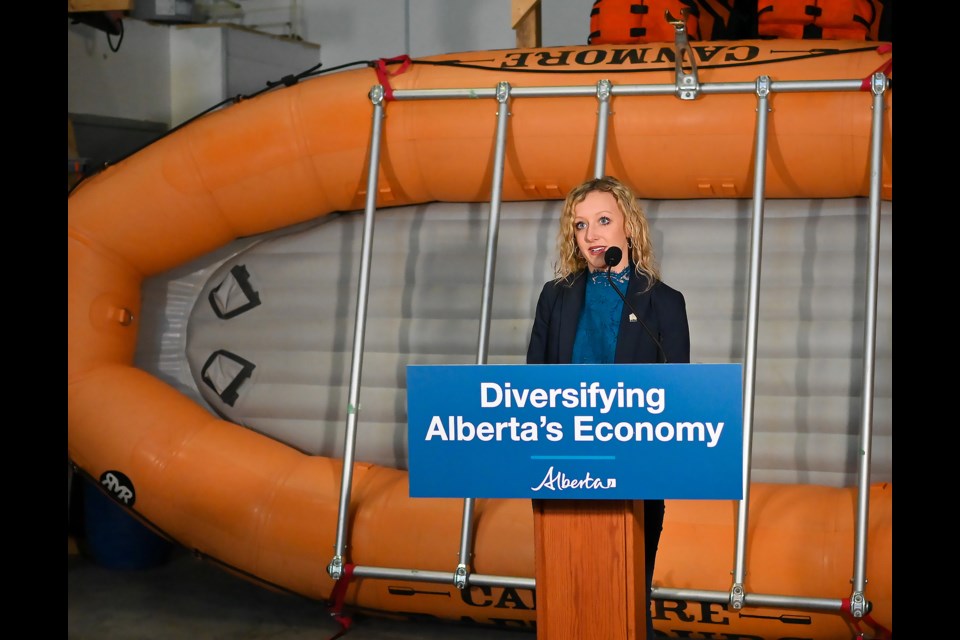DEAD MAN’S FLATS – The province is making its largest ever contribution to the development of authentic, Indigenous-owned and operated visitor experiences to diversify Alberta’s rural tourism economy.
On Tuesday (April 4), the Alberta government announced $10 million over two years to develop environmentally sustainable year-round experiences in regions outside of Alberta’s most popular destinations.
“Investments like this support Indigenous entrepreneurs who offer amazing tourism experiences that showcase the stories, wisdom and diversity of Indigenous cultures in less-visited areas of the province,” said Shae Bird, CEO of Indigenous Tourism Alberta (ITA), during a press conference.
“More importantly, these partnerships help support the economic and cultural revitalization of our Indigenous communities and offer a chance for Canadians to connect with Indigenous peoples as part of their own reconciliation journeys.”
The announcement was made from the Canmore Raft Tours warehouse in Dead Man’s Flats, on the doorstep of popular tourist destinations like Canmore, Banff and Kananaskis. It’s also in the traditional territory of nearby Îyârhe Nakoda First Nation.
The Chiniki Cultural Centre and Nation-owned Stoney Nakoda Resort and Casino are popular stops for travellers along Highway 1, but Indigenous tourism is lacking in the area overall, despite the land and its peoples' incredibly rich history.
The $10 million in funding is being funnelled through Travel Alberta via the 2023 budget to support, expand and enhance tourism experiences, including agrotourism, interpretive and educational programming, and local and outdoor touring opportunities.
Last month, Travel Alberta also announced it will provide $6 million in direct and in-kind support over three years to ITA. The investment will enable more Indigenous tourism operators to develop new tourism products, expand existing offerings and more effectively market and attract visitors to their experiences.
Bird said elevating the voices of Indigenous entrepreneurs and business owners is a priority of ITA’s mandate to promote economic prosperity and address gaps in knowledge of Indigenous peoples. The tourism agency’s membership system supports businesses that have a staff base of 51 per cent or more Indigenous peoples.
ITA aims to use the funding to support Indigenous-led, culturally appropriate visitor experiences.
Some attempts to showcase First Nations and Métis cultures in the Bow Valley, and in other areas of the province, have not taken as much consideration.
“We do see a gap in education and what’s appropriate and not appropriate, so we utilize our resources to support that side of the sector to ensure that everyone’s set up for success, and moving forward in an authentic and appropriate way,” said Bird.
The Alberta government is increasing funding to Travel Alberta in budget 2023 by 14 per cent. Travel Alberta’s Tourism Investment Program provides $15 million in annual funding to support tourism operators.
In 2022-23, Travel Alberta funded 166 projects across 73 communities – about 75 per cent of the projects and 70 per cent of the funding were in smaller urban and rural areas of the province.
“Through these efforts, we’re enabling Alberta operators to increase the breadth and appeal of our province’s rural tourism offerings and cast a wider net to attract visitors,” said Todd Loewen, Minister of Forestry, Parks and Tourism. “Realizing the growth potential of our lesser-known tourism destinations will unlock long-term economic opportunities that benefit rural Albertans and Indigenous peoples and communities throughout the province.”
Banff-Kananaskis MLA Miranda Rosin, who is also the parliamentary secretary for tourism, said she sees great opportunity in the increased funding for more communities to develop and prosper from visitor-based economies like some in the area have.
Banff, Canmore and Jasper together attracted $2.3 billion in visitor expenditures in 2019, contributing $2 billion in total GDP, 23,600 jobs and $308 million in taxes to the economy, according to a recent Verum Consulting report prepared for the towns.
The mountain towns have also experienced challenges maintaining visitor populations, however. In 2021, Banff, Canmore and Jasper spent $20.5 million, $15 million and $6.5 million, respectively, to support visitor infrastructure.
While the towns continue to experience challenges supporting millions of visitors each year and solutions remain to be implemented, Rosin said there is much to be learned from tourism in the Bow Valley and applied to other, less-travelled areas of the province, to spread the wealth.
“These communities have done such an amazing job of building an incredible tourism industry that has put Alberta really on the map globally,” said Rosin.
“They really are industry leaders and if we can work with them, harness the innovation and passion they have for tourism all across the province … the rest of the province can reap the benefits and recognize the incredible opportunities that tourism can bring them, too.”
According to the province, about 30 per cent of tourism spending already occurs outside of the Canadian Rockies and Edmonton and Calgary regions. The province is developing rural tourism as a key contributor to achieving its goal of growing the tourism industry into a $20-billion opportunity within a decade.
The Local Journalism Initiative is funded by the Government of Canada. The position covers Îyârhe (Stoney) Nakoda First Nation and Kananaskis Country.




